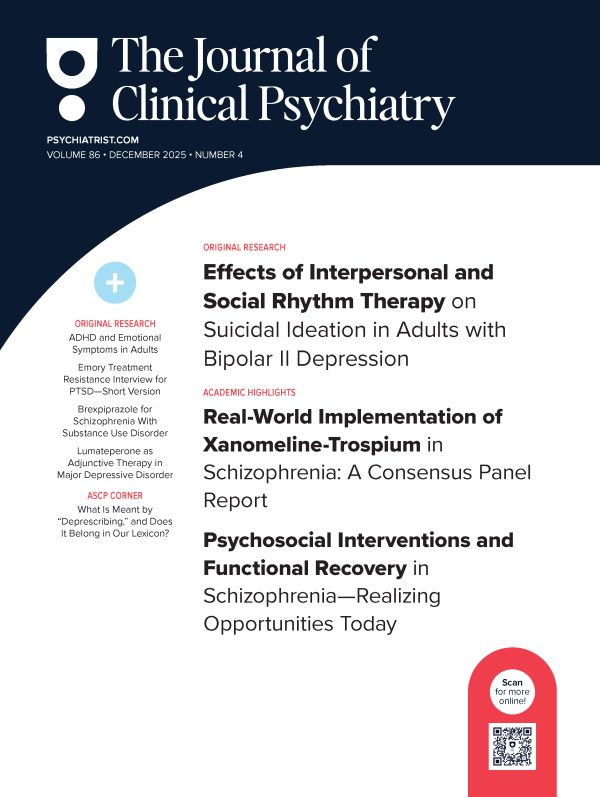See letter by Swami and Mishra and article by Uher et al
Dr Uher and Colleagues Reply
To the Editor: We thank Drs Swami and Mishra for the opportunity to clarify some points about using the interest-activity symptom dimension to personalize treatment for major depressive disorder. Their letter raises several issues on how the interest-activity scale is constructed and used.
First comes the question of whether it is appropriate to use a simple sum of the interest-activity items rather than a more complex and sophisticated method that gives specific weight to each item. Our choice of the simple sum of items method in the Canadian Biomarker Integration Network in Depression trial (CAN-BIND)1 was based on experience from previous work in the Genome-based Therapeutic Drugs for Depression (GENDEP) and Sequenced Treatment Alternatives to Relieve Depression (STAR*D) studies.2 The interest-activity was originally derived in GENDEP from 3 depression rating scales using scoring based on item response theory, which estimates weights and thresholds separately for each item and each response option according to a psychometric model.2 However, when we constructed an alternative interest-activity score as a simple sum of items, it correlated almost perfectly (Pearson product-moment correlation = 0.97) with the score derived using the much more complex method. The STAR*D study used 2 different depression rating scales. The STAR*D interest-activity score was constructed using a simple sum of items with equivalent content, and it predicted outcomes of treatment with undiminished effect size. CAN-BIND applied 2 depression rating scales, of which one was previously used in GENDEP and one in STAR*D. Therefore, prior weights were available for only one of the scales. Given prior experience, we believe that the ease of application of the summed score method outweighs uncertain advantages of more complex scoring procedures with item-specific weights.
The second point that we would like to address concerns the joint use of items from a self-report questionnaire and a clinician-rated scale. Previous work demonstrated that self-report and clinician rating each provide unique information predictive of antidepressant treatment outcome.3 This is also true of interest-activity symptoms. Self-report and clinician rating contribute evenly to the prediction but are not mutually replaceable. Researchers who plan to replicate or extend our findings and clinicians who wish to use interest-activity symptoms to aid decision making in practice should use a combination of self-report and clinician rating to achieve optimal results. The CAN-BIND publication demonstrates that 3 self-report questions and 3 clinician-rated items are sufficient to obtain meaningful prediction. Together with simple sum rating, this makes interest-activity measures unobtrusive and easy to apply.
Additional points raised by Drs Swami and Mishra include suggestions for other factors that may also be predictive of treatment outcomes. Our published article reports hypothesis-driven analyses focused on the interest-activity dimension.1 CAN-BIND has collected a wealth of information, and ongoing work uses multivariate methods that consider interest-activity alongside multiple other factors.4 The results of these analyses, to be reported in the near future, will answer most of these important questions.
References
1.Uher R, Frey BN, Quilty LC, et al; CAN-BIND Investigator Team. Symptom dimension of interest-activity indicates need for aripiprazole augmentation of escitalopram in major depressive disorder: a CAN-BIND-1 report. J Clin Psychiatry. 2020;81(4):20m13229. PubMed CrossRef
2.Uher R, Perlis RH, Henigsberg N, et al. Depression symptom dimensions as predictors of antidepressant treatment outcome: replicable evidence for interest-activity symptoms. Psychol Med. 2012;42(5):967-980. PubMed CrossRef
3.Uher R, Perlis RH, Placentino A, et al. Self-report and clinician-rated measures of depression severity: can one replace the other? Depress Anxiety. 2012;29(12):1043-1049. PubMed CrossRef
4.Kennedy SH, Lam RW, Rotzinger S, et al; CAN-BIND Investigator Team. Symptomatic and functional outcomes and early prediction of response to escitalopram monotherapy and sequential adjunctive aripiprazole therapy in patients with major depressive disorder: a CAN-BIND-1 report. J Clin Psychiatry. 2019;80(2):18m12202. PubMed CrossRef
aDalhousie University, Department of Psychiatry, Halifax, Nova Scotia, Canada
bNova Scotia Health, Halifax, Nova Scotia, Canada
cDepartment of Psychiatry, University of British Columbia, Vancouver, British Columbia, Canada
dDepartment of Psychiatry, University of Toronto, Ontario, Canada
eDepartment of Psychiatry, St Michael’s Hospital, University of Toronto, Ontario, Canada
Published online: December 8, 2020.
Potential conflicts of interest: Please refer to original publication [J Clin Psychiatry 2020;81(4):20m13229].
Funding/support: This research was conducted as part of the Canadian Biomarker Integration Network in Depression (CAN-BIND), an Integrated Discovery Program supported by the Ontario Brain Institute, which is an independent non-profit corporation, funded partially by the Ontario Government. Additional funding was provided by the Canadian Institutes of Health Research, Lundbeck, Bristol-Myers Squibb, and Servier. Funding and/or in-kind support was also provided by the investigators’ universities and academic institutions. Dr Uher has received additional support from the Canada Research Chairs Program (award number 231397), the Canadian Institutes of Health Research (grant reference number 148394), and the Dalhousie Medical Research Foundation.
Role of the sponsor: The supporters had no role in the design, analysis, interpretation, or publication of the study.
Disclaimer: The opinions, results, and conclusions are those of the authors, and no endorsement by the Ontario Brain Institute is intended or should be inferred.
J Clin Psychiatry 2021;82(1):20lr13628a
To cite: Uher R, Lam RW, Kennedy SH. Dr Uher and colleagues reply. J Clin Psychiatry. 2021;82(1):20lr13628a.
To share: https://doi.org/10.4088/JCP.20lr13628a
© Copyright 2020 Physicians Postgraduate Press, Inc.
This PDF is free for all visitors!





